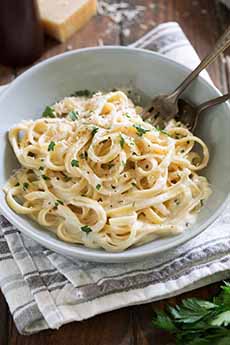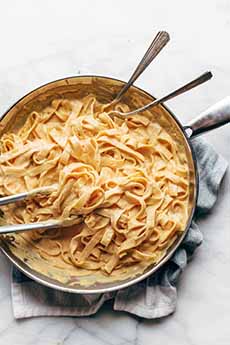TODAY IN FOOD: It’s National Fettuccine Alfredo Day
|
Fettuccine Alfredo is rich comfort food, made from fettuccine, ribbon-shape strands of pasta (fettucce means “small ribbons” in Italian). Wider than the other popular flat shape, linguine, fettuccine provide a better surface for catching rich and creamy sauces. (Fettuccine is similar to tagliatelle, the flat pasta from the northern Italian region of Emilia-Romagna, but is narrower. See our Pasta Glossary for more shapes.) To make Fettuccine Alfredo, the pasta is tossed with cream, butter and Parmigiano-Reggiano cheese. The cheese melts when tossed with the hot pasta, cream and butter, creating a sauce (at home, the ingredients are simply stirred on the stove top. In a restaurant, tossing at tableside is part of the experience. The original recipe was created in 1914 by Alfredo Di Lelio, owner of Alfredo alla Scrofa, a restaurant in Rome. It is simply a variation of traditional Italian recipes, fettuccine al burro (fettuccine with butter) and fettuccini al burro e panna (with butter and cream)—both served, of course, with grated Parmigiano-Reggiano. Alfredo tweaked the traditional recipe slightly. When butter is added both before and after fettuccine is put in the serving bowl for tossing, it is known as doppio burro, double butter. Di Lelio doubled the amount of butter in the bowl before the fettuccine was added, creating a triplo burro, triple butter, recipe: more butter made more of a sauce. Why? The chef created the dish to entice his pregnant wife, who had lost her appetite. He served it with egg fettuccine, hoping that the “nutritious dish” would do the trick. Today, we know that a typical serving of the “nutritious dish” has 455 calories, 38g of fat, 291mg of sodium and 143g of cholesterol. But for people who love rich, creamy food, it hits the spot! According to Musso & Frank Grill in Hollywood, the recipe for Fettuccine Alfredo was brought to America by silent film stars Mary Pickford and Douglas Fairbanks. While honeymooning in Rome in 1920, they dined at Alfredo alla Scrofa, had the dish, and liked it so much that they asked for the recipe. They brought the recipe back to Los Angeles, to Musso and Frank Grill, which had opened the year before. Not surprisingly, it became a hit (source). It became known as Fettuccine Alfredo. By the way, in Italy, fettuccine Alfredo and Alfredo sauce are not common terms. Instead, order fettuccine al burro e panna—triplo burro. In the U.S., additions proliferated: green peas, chicken, lobster and other seafood, mushrooms, sun-dried tomatoes. One of our favorites is salmon caviar. In addition to the Parmesan, you can add an extra cheese: crumbled blue cheese, for example. For something different, try these recipes: |
|
|
|
|
||


